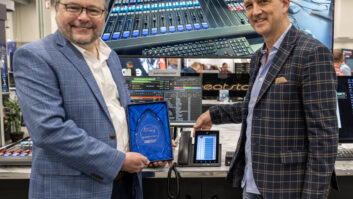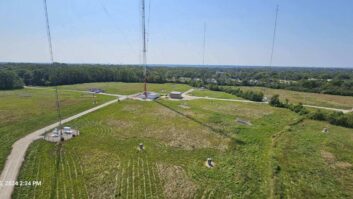We’ve written here before about microphone placement in studios, specifically how the monitors and mic arms or booms can cause control room countertop clutter as well as disrupt sightlines among the talent.

Fig. 1: A “boogie board” suspended from the ceiling holds mic arms and video monitors.
When Chris Wygal, operations manager and engineer for Liberty University’s The Journey network, was remodeling his control room, making the best use of counter space was paramount.
With a multi-person morning show, mounting the mic arms and monitors in the console furniture tabletop wasn’t going to cut it. After some study, Chris came upon a novel design: a surfboard, or more appropriately, a shorter “boogie board,” structure suspended from the ceiling, as seen in Fig. 1.

Fig. 2: Standard mic mounting and monitor hardware is used, only inverted!
Fig. 2 shows how the mic arms are mounted to a pedestal, which connects to the surfboard. The board is then suspended from the ceiling.
For the fabrication of the boogie board and the secure mounting, Chris turned to Liberty’s facilities department. They not only cut and finished the board; the department’s structural engineers also determined the best way to attach it. They tied a new subfloor about 4 inches above the suspended ceiling, spanning the room with 2x8s crisscrossing the room to create a structure that would stabilize the board completely. Two 3-inch diameter pipes are bolted to the new subfloor. These extra steps create a non-swaying base for mounting the mike and monitor hardware.
I spoke to George and Jason Neil with Graham Studios (www.graham-studios.com). They said their company could design and fabricate the “surfboard” but cautioned readers to secure the services of a local structural engineer in designing and fabricating the best means of secure attachment to the deck above.

Fig. 3: The surfboard holds mics and monitors efficiently.
Keep in mind that most mic arms are pulled, pushed or otherwise adjusted by the talent before every break. This could amount to hundreds of times a day. You don’t want the surfboard to come loose, so secure the skills of a professional if you go this route.
Most will admit the finished product looks amazing, and when professionally secured, not only keeps the countertop clear but should provide years of service (see Fig. 3).
***
Larry Wilkins is a retired regional engineer for Cumulus and director of the Alabama Broadcasters Association Engineering Academy. Seeing the need to provide proper training for broadcast engineers, Larry has worked with the ABA to offer a series of in-person tutorial sessions, covering a variety of topics related to both radio and television broadcast engineering.
Perhaps the best part of these offerings is the cost; most are free. You just need to get to the training center in Hoover, Ala.
In addition to teaching classes in broadcast theory, Larry shares a lot of practical knowledge, gleaned from his years as a regional engineer. For instance:
With the warmer weather upon us, broadcast engineers know all too well that transmitter sites often become a “bed and breakfast” for various uninvited guests. Rats, snakes, wasp, spiders and other guests can take up residence inside our transmitter buildings. Besides being a nuisance, they can also be dangerous to our health.
A serious condition is Hantavirus pulmonary syndrome. It is a respiratory disease transmitted by infected rodents through their urine and droppings. Humans can contract the disease when they breathe in aerosolized virus. How can the virus become airborne? Think of that wet/dry vacuum used to clean up the mess.
Make sure that openings that would allow access to the building by these guests are addressed, even during the design, construction and maintenance of transmitter sites. The “No Vacancy” sign should always be on.
Any removal or cleanup from these pests should only be done while wearing a breathing mask and gloves, and then spray the building with a good disinfectant. Better still, call in a company that does this type of work. You’re not being paid enough to put your health at risk!
Here’s a link Larry provided for more information on Hantavirus: http://southernnevadahealthdistrict.org/health-topics/hantavirus.php.
Find more information on the ABA Academy at http://al-ba.com/wp2/aba-engineering-academy/. Some of the classes are also found on the YouTube channel of ABA Engineering Academy.
Some upcoming courses include “Understand Digital Audio Workstations” (Aug. 3), “Basic Radio Broadcast Engineering” (Oct. 2–6), “Basic Television Broadcast Engineering” (Oct. 23–27) and “Advanced Radio Broadcast Engineering” (Dec. 4–8).
Additional seminar dates will be announced soon, for include topics such as audio/video over IP, solid-state transmitters, video ingest/playout systems and broadcast antennas. For more information on these free seminars, contact Larry Wilkins at [email protected].
Workbench — Radio World’s iconic and most popular column — relies on your good, practical ideas and those of your colleagues. Send in tips big or small; help your fellow engineers and qualify for SBE recertification credit. Email [email protected]. You can even (gasp) fax them to (603) 472-4944. And discover a trove of past tips by clicking on the Columns & Views tab at radioworld.com, then choosing Workbench.
John has spent almost five decades in the broadcasting industry and yet he is still learning. He handles West Coast sales for the Telos Alliance; he is SBE-certified and is a past recipient of the SBE’s Educator of the Year Award.







